As Gas Prices Go Up, Congress Talks a Shift to Made in America Electric Vehicles
Share

It’s critical that electric vehicles — and the supply chain that helps build them – are Made in America. Otherwise, we’ll merely shift our dependence on foreign oil to foreign-made EVs.
With rising gas prices and the climate crisis creating additional momentum for a transition to electric vehicles (EVs), Members of Congress this week examined ways to further support the shift and build the infrastructure needed to support millions of new electric-powered cars, trucks and SUVs.
A House Energy and Commerce subcommittee met on Tuesday to examine the state of America’s EV industry, with the spike in gas prices thanks to Vladimir Putin’s unjustified invasion of Ukraine driving much of the discussion. Now more than ever, Americans are looking for ways to reduce costs and their carbon footprint, and many manufacturers want them to know they stand ready to make EVs in the USA.
“Nearly every week, there are announcements of new EV and battery factories being built throughout the nation. Companies like Ford, General Motors, and Tesla are making investments across the country,” said Rep. Frank Pallone (D-N.J.), chairman of the full committee. “These investments are occurring in traditional automotive manufacturing states like Michigan, but also in new, emerging manufacturing hubs in the Southeast. Domestic EV sales nearly doubled in the last year and the auto industry has clearly seen the writing on the wall. Consumers want EVs, and the industry is delivering.”
Pallone praised the new Bipartisan Infrastructure Law, including its Buy America provisions, noting that it invests $7.5 billion in EV charging infrastructure and $6 billion for domestic manufacturing and processing of EV components like batteries and charging equipment. “This funding will strengthen American and ensure more of these components are made right here, and not in China,” Pallone said.
Bob Holycross, vice president for Sustainability, Environment and Safety Engineering at the Ford Motor Company, noted that his company is following consumer demand for EVs. In fact, Holycross predicted that Ford could be making up to 2 million EVs annually by 2026.
But while Holycross and other panelists agreed that the Bipartisan Infrastructure Law has been a “great first step,” they also struck a similar chord that more needs to be done. More investment is needed to build out a domestic EV supply chain and create the infrastructure needed to power the new clean energy vehicles.
“The United States is at an inflection point – we can see the environmental need and customer demand for innovative, high-performance electric vehicles, but if we are to be world leaders in this space we must pivot quickly,” Holycross said. “To be clear, if U.S. policies are not efficient and effective in this transition, we risk being outpaced by global competitors like China and Europe.”
In the absence of additional federal action, some states have been seeking solutions that help break down some of the barriers to entry for consumers and companies alike. Florida, for example, is installing chargers along evacuation routes and key toll roads; Colorado is working with rural communities to make EVs accessible to those outside the city limits.
It also will be critical to reaching out to those communities who have often been left behind, the staple of Natalie King’s Detroit-based company, Dunamis Clean Energy Partners, LLC.
King’s Black-and woman-owned business, which provides energy management and energy efficient products and services, is, “proud that our chargers meet Buy America, Build America requirements for steel, iron, manufactured products and construction materials,” King said.
“In addition, our products will be Made in America, by American workers,” she added.
“It’s our commitment to have American workers make a superior made American EV charging product, which will also lessen our dependency on outside countries, like China,” King continued. “If we have the control over how we create, how we engineer, how we design, how we maintain our network software through our EV infrastructure presence, then we now have the ability to control cyberattacks, hacking from an outside sources, like a dominating China.”
Investing in EVs is not just about what comes off the assembly line. As Ford, GM, and its competitors are scrambling to invest in new or existing plants across the country, communities are seeing additional economic benefits.
For example, Ford is expected to create 11,000 new direct jobs from its plants in Kentucky and Tennessee, and the benefits of building out domestically are potentially astounding: one direct job at an EV plant could support 13 to 14 jobs in the surrounding communities.
“We have started, in a number of ways, to bring back more manufacturing an R&D back to the U.S… we’re proud of the investments we’ve made… 80% of what we build here is sold here,” Holycross said.
Many members pressed panelists on the sourcing of rare earth minerals and other EV components, strongly suggesting that any EV path forward push out Chinese suppliers and focus on strengthening domestic manufacturing.
Ford is partnering with Nevada-based Redwood Materials to build out a domestic supply chain for batteries, Holycross said. But he warned that if the United States wants “to be world leaders in this space, we must pivot quickly… we need to strengthen our domestic supply chain.”
And as Subcommittee on Energy Chairman Bobby Rush (D-Ill.) pointed out, doing so amounts to a matter of national security, given the peril of remaining dependent on foreign oil.
“These investments in EVs are good for the environment, good for our pocketbooks, and good for our national security… they are a win-win-win,” he said.
